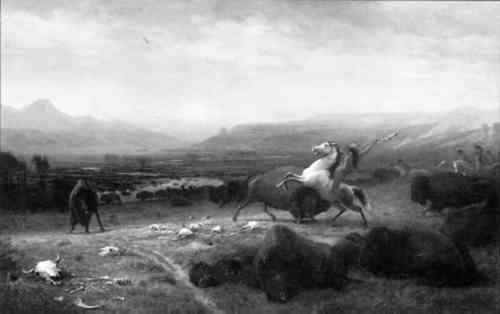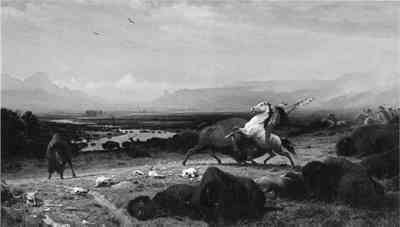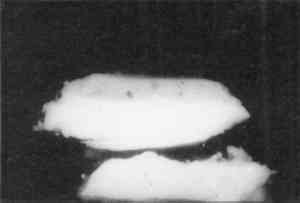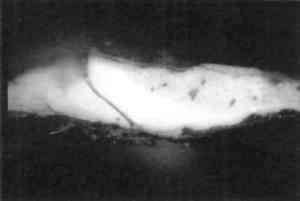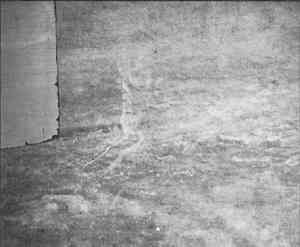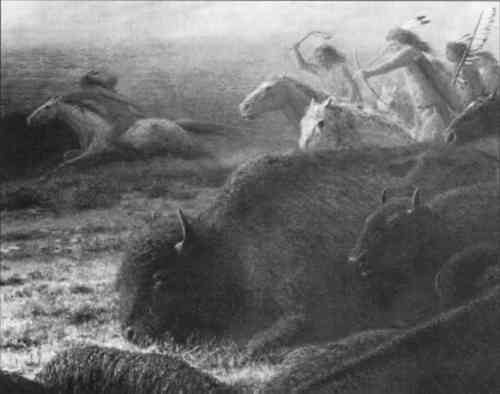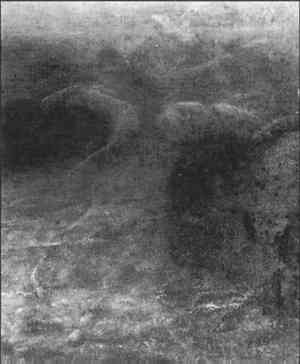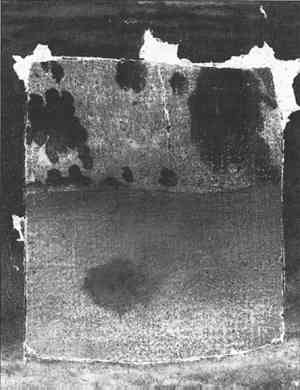CORCORAN AND CODY: THE TWO VERSIONS OF THE LAST OF THE BUFFALODARE MYERS HARTWELL, & HELEN MAR PARKIN
ABSTRACT—Albert Bierstadt (1830–1902) painted two versions of The Last of the Buffalo: a large one in the Corcoran Gallery of Art in Washington, D.C., and a somewhat smaller version in the Buffalo Bill Historical Center in Cody, Wyoming. The two paintings are similar but not identical in construction, palette, and design. In the Cody painting, the same compositional elements are smaller, and the internal space is compressed. Both paintings contain many of the same design changes and pentimenti, indicating that one is not a copy of the other. The authors use contemporaneous evidence to formulate a hypothesis as to why, and in what order, Bierstadt painted the two versions. Cross sections reveal a graphite-containing layer between the canvas and the ground in the Cody painting, tying this painting to others painted in the 1880s. Surface texture and condition of both paintings are discussed in relation to materials used and previous treatments. Finally, the retexturing and inpainting of a large, compositionally important area in the Cody painting are discussed in detail. TITRE—Corcoran et Cody: Deux versions du tableau The Last of the Buffalo. R�SUM�—Albert Bierstadt (1830–1920) cr�a deux versions du tableau The Last of the Buffalo (Le Dernier des Bisons): une toile de grande dimension maintenant au Mus�e d'art Corcoran � Washington, D.C., et une autre de plus petit format dans la collection du Centre historique Buffalo Bill, � Cody au Wyoming. Les deux tableaux sont similaires, mais diff�rent par leur construction, palette et composition. Dans le tableau de Cody, les �l�ments de composition sont de plus petites dimensions et l'espace int�rieur r�duit. Les deux tableaux comprennent plusieurs changements similaires dans leur composition et des repentirs, ce qui d�montre qu'ils ne sont pas des copies l'un de l'autre. En utilisant des preuves contemporaines � l'artiste, les auteurs formulent une hypoth�se sur les raisons pour lesquelles et dans quel ordre chronologique les deux versions furent peintes par Bierstadt. Pour le tableau de Cody, des coupes transversales r�v�lent une couche contenant du graphite entre la toile et la pr�paration, ce qui relie ce tableau � d'autres peints lors des ann�es 1880. La texture de la surface et l'�tat des deux tableaux sont discut�s, ence qui a trait aux mat�riaux utilis�s et aux traitements de restauration ant�rieurs. Enfin les retouches et la texturation de la surface d'une section importante de la composition du tableau de Cody y sont aussi d�taill�es. TITULO—Corcorany Cody: las dos versiones de “El �ltimo de los b�falos”. RESUMEN—Albert Bierstadt (1830–1902) pint� dos versiones de “El�ltimo de los b�falos” (The Last of the Buffalo), una de gran tama�o que esta en la Galer�a de Arte Corcoran en Washington D.C., y una versi�n m�s peque�a que est� en el Centro Hist�rico de Buffalo Bill en Cody, Wyoming. Las dos pinturas son similares pero no id�nticas en su construcci�n, paleta y dise�o. En la pintura de Cody, los mismos elementos de la composici�n son m�s peque�os y el espacio interno est� comprimido. Ambas pinturas contienen muchos de los mismos cambios de dise�o y pentimentos, indicando que una no es una copia de la otra. Los autores usan evidencia contempor�nea para formular una hip�tesis con respecto al porqu� y en qu� orden, Bierstadt pint� las dos versiones. Los cortes estratigr�ficos revelaron la presencia de una capa que contiene grafito entre el lienzo y la 1 INTRODUCTIONIn 1888, in preparation for the Paris Exposition the following year, Albert Bierstadt (1830–1902) began work on the last of his large Western showpieces and his most important late painting, The Last of the Buffalo. Probably because by this date Bierstadt's work was considered pass�, the painting was rejected by the American selection committee for the exposition, causing a minor sensation in the press and much pain to the artist. Bierstadt subsequently sent the painting to the exposition on his own, which he was entitled to do as a Chevalier of the Legion of Honor (Hendricks 1988). Today, of course, the painting is one of the icons of American art and among the most treasured holdings of the Corcoran Gallery of Art, Washington, D.C. (fig. 1).
For many years the Corcoran painting was considered to be the only version of The Last of the Buffalo, but about 1955 another was found in England and brought to the United States by a dealer (Nicholson 1956). The second painting eventually entered the collection of the Buffalo Bill Historical Center in Cody, Wyoming (fig. 2). By coincidence, both works underwent conservation treatment in 1984–85, precipitating this investigation into the relationship of the two paintings. The Corcoran painting was treated by the museum's conservator, Dare Myers Hartwell; the Cody painting was treated by Perry Huston and Helen Mar Parkin of
2 ANALYSISBoth paintings are executed in an oil-based paint on medium-weight, tabby weave linen canvas and are remarkably similar in appearance. However, the Corcoran painting is 11 1/8 in. taller (28.2 cm) and 22 1/4 in. wider (56.5 cm) than the Cody version. The Corcoran painting had been lined twice prior to 1984 and was not mounted on its original stretcher. Nevertheless, its tacking margins indicate that within approximately onequarter inch these are the original dimensions. The dimensions of the Cody painting/represent those of the stretcher added during a restoration undertaken about 1955, just prior to its sale. The dealer had the painting lined and mounted on a new stretcher because he considered the original panel-back stretcher, a type often used by Bierstadt, too heavy (Nicholson 1956). The tacking margins have been irregularly cut off and part of the farthest antelope to the left is missing, suggesting that more has been cut off along the left than along the other sides. Nevertheless, a comparison of the two compositions indicates that the Cody version is substantially complete, and the difference in size cannot be accounted for by the painting's having been cut down. Instead, because of its smaller size the Cody painting is slightly reduced in scale in relation to the Corcoran painting. Compositional elements are smaller, and the internal space is compressed. For example, the large standing buffalo at left is about 10% smaller in the Cody version. The compression of space is most apparent in details, such as the distance between the animals in the right foreground; in the Cody painting the buffalo are much closer together, and less of the dead horse is visible between them. Other differences, less important to the sense of space, also occur; in the Cody painting, the buffalo at the right center edge are running, while in the Corcoran version they have fallen to the ground. While the Corcoran painting has a slightly warmer (more yellow) palette, particularly in the sky, both paintings follow the technique establshed by Bierstadt early in his career. Cross sections reveal a thick lead-white preparation over which thin, relatively opaque layers of oil paint have been applied to build up the design (Berrie and Palmer 1986, 1988a, 1988b). In the Cody painting, however, between the canvas and the
Analysis of the paint in the sky reveals that in both paintings the blue is composed of a mixture of natural ultramarine and cobalt blue (with a slight predominance of the former) with lead-white. Analysis of the dark green at the left tacking The texture of the canvas is clearly visible through the paint and ground in both paintings. In addition, both paintings have a curiously granular surface appearance, in contrast to the smoother surfaces that Bierstadt's paintings usually exhibit. It is possible that Bierstadt may actually have textured the ground layer. In the Corcoran picture the paint suffers from a lack of binding medium, which increases the granular effect. In the course of treatment, the paint was found to be quite fragile and poorly attached to the ground, with pinpoint losses throughout. In the Cody painting the granular appearance is intensified by an overall pattern of tiny wrinkling in the paint, which could have been caused by inadequate adhesion between the slick, greasy graphite layer and the lead-white ground or between the ground and paint, a condition perhaps exacerbated by the glue lining. Abrasion from previous cleanings has made the surface texture more apparent in both paintings, particularly the Cody, in which extensive damage has occurred in the dark paint layers of the foreground. In the darks of the Corcoran painting there is also a small network of shrinkage cracks through which the white ground is visible. These cracks do not appear in the Cody picture. They may be the result of 3 RELATIONSHIP OF THE TWO PAINTINGSThere are numerous studies for individual elements in the composition of The Last of the Buffalo. However, no sketch for the entire painting exists, and it is apparent that the overall composition was still being worked out by Bierstadt as he painted. Many changes in location and scale of figures can be found in the middle ground of both paintings, and, in fact, certain areas appear to contain the same design change. Some of these changes are visible on the surface of the painting as pentimenti, while others are revealed by x-radiographs or examination with the infrared Vidicon camera. For example, a pentimento of an antelope is visible in both paintings immediately to the right of the standing buffalo at left (figs. 5, 6). At the right between the rearing horse and the buffalo herd, both paintings have a pentimento of a large mounted figure drawing back a bow (figs. 7–10). It should be noted that the scale of these pentimenti differs from that of the surrounding figures, indicating that Bierstadt was moving compositional elements back and forth in space
Compositional sketches are rarely found for Bierstadt's large studio paintings, and design changes, particularly in the middle ground, are not uncommon. However, the number and scale of the changes in The Last of the Buffalo seem to indicate that Bierstadt had more than the usual difficulty working out the composition in both paintings. Furthermore, the presence of similar design changes in two large versions of a painting may be unprecedented. It eliminates the possibility that one painting is a copy of the other and leaves the relationship between the two paintings puzzling. In an unidentified and undated newspaper clipping titled “No Place for Bierstadt—The Last of the Buffalo' excluded from the Paris Exposition,” Bierstadt is quoted as saying, “That is the study (pointing to a huge painting) for the picture now in the Salon” (Bierstadt scrapbook). Because the Corcoran version is unquestionably the one sent to the Salon, it seems likely that the artist was referring to the Cody picture. If one trusts the accuracy of this account, the Cody picture must be the preliminary version. However, we know that Bierstadt did not normally paint studies for entire compositions and certainly not on this scale. Furthermore, the numerous changes in scale and location of figures in both paintings indicate that Bierstadt was not able to solve the problem of spatial relationships in the “study.” Although we cannot be certain without further documentary evidence, it seems likely that, in order to deal with these spatial problems, at some point in the painting process the artist decided to switch from the Cody picture to the larger format of the Corcoran picture, in which 4 TREATMENTToday, the most dramatic compositional difference between the paintings is the absence in the Cody version of a 10 1/4 in. � 8 7/8 in. area (26 � 22.5 cm) at left center, removed at some point in the past. The large standing buffalo at left, seen in the Corcoran painting turning toward the viewer and eyeing the mounted figure at right, is missing in the Cody painting, replaced by a canvas insert that has a much smoother surface texture (fig. 11). The reason for this violent intrusion upon the artist's intention is not clear.
During the treatment of the Cody painting, this missing buffalo presented a challenging inpainting problem. Peter Hassrick, director of the Buffalo Bill Historical Center, had expressed a wish that the insert not be removed and that its outline be left visible under certain viewing conditions to document the actual extent of original design and the history of the treatment of the painting. The removal of repaint in this area revealed that the insert had been cut from another painting and depicted part of a crudely painted brown-and-white cow. It had been glued in upside down, then repainted to blend with the surrounding landscape (fig. 12). Upon close inspection, traces (the reddish brown tip of the hump and the long shadows below the hooves) of the buffalo that had originally occupied the space were
Before inpainting could be carried out, however, it was necessary to adjust the surface texture in the insert area so that it would be less noticeable to the viewer. The painting was first given a brush coat of Soluvar Gloss varnish (a proprietary acrylic resin, probably an n-butyl methacrylate/n-butyl acrylate copolymer, made by Binney and Smith for Liquitex). When the varnish had dried completely, an impression was taken of the surface adjacent to the insert area, using a two-part silicone rubber mold material first used by Gregory A. Thomas, painting conservator, to take surface impressions of paintings (Dow Corning RTV 3110). To take the impression, a 1/8 in. (.3 cm) deep dam, slightly larger than the insert, was constructed using strips of four-ply mat board. The liquid mold material was then troweled carefully into the area and smoothed until it entirely filled the dam. It was allowed to cure overnight, after which the finished mold was peeled slowly away from the painting, resulting in a detailed negative reproduction of the surface texture. The mold was placed face up on a large hot plate and warmed to approximately 200�F. Molten microcrystalline wax (Bareco Victory White, melting point 165�F) was brushed thinly onto the mold. Meanwhile, the area of the insert was warmed with an incandescent light held close to the surface, while the surrounding area of the painting was protected from overheating by strips of aluminum foil. The warm, waxed mold was then turned face down onto the area of the insert and pressed into place, using the fingertips, for several minutes until the wax cooled. The mold was then peeled away slowly. The thin wax layer remained on the surface of the painting, transferring the texture to the insert area. The edges of the waxed area were then textured locally with a dental tool to blend with surrounding areas, thereby softening the transition line. A 35mm color slide of the corresponding area on the Corcoran painting was projected onto the textured area and adjusted until it lined up precisely with the remaining original clues of the hump and shadows below the hooves. (In fact, because of the preciseness of this fit, it is tempting to speculate that Bierstadt may originally have used lantern slides to transfer some of the composition elements from the Cody to the Corcoran painting.) The outline of the buffalo was then drawn, and the inpainting was completed using dry pigments ground in poly(vinyl acetate) AYAC (Union Carbide). An 8 � 10-in. (20.3 � 25.4) color transparency of the Corcoran buffalo and a steel plate engraving made after the Corcoran painting were used for reference in the reconstruction. By reintegrating this important design element into the Buffalo Bill Historical Center's Last of the Buffalo, the painting has been returned more closely to Bierstadt's original intention. ACKNOWLEDGEMENTSThe authors would like to express their appreciation to both the Corcoran Gallery of Art and the Buffalo Bill Historical Center for the support of their research, and in particular wish to thank Perry Huston, Nancy Anderson, Franklin Kelly, and the staff of the Scientific Research Department at the National Gallery of Art who carried out the technical analysis of both paintings. REFERENCESNote: All unpublished reports are available upon request from the authors.Berrie, B. H., and Palmer, M. R.1986. Analysis report/Bierstadt, A./The Last of the Buffalo/9.12 Corcoran Gallery. Corcoran Gallery of Art, Washington, D.C. Berrie, B. H., and Palmer, M. R.1988a. Analysis report/Bierstadt, A./The Last of the Buffalo/Owner: Buffalo Bill Historical Center (Cody, WY). Corcoran Gallery of Art, Washington, D.C. Berrie, B. H., and Palmer, M. R.1988b. Analysis report/Bierstadt, A./The Last of the Buffalo/9.12/Owner: Corcoran Gallery. Corcoran Gallery of Art, Washington, D.C. Bierstadt scrapbook and documents. Joyce Randall Edwards Collection, Dobbs Ferry, N.Y. Hartwell, D. M.1999. Bierstadt's late paintings: Methods, materials, and madness. Journal of the American Institute for Conservation38(1):33–44. Hendricks, G.1988. Albert Bierstadt. New York: Harrison House. Lomax, S. Q.1989. Analysis report/The Last of the Buffalo/Bierstadt/The Buffalo Bill Historical Center, Cody, WY/Analysis of media of ground sample. Corcoran Gallery of Art, Washington, D.C. Nicholson, J. P.1956. Letter to Horace L.Hotchkiss, Jr., curator, February 20. Corcoran Gallery of Art, Washington, D.C. Palmer, M. R.1989. Analysis report/Bierstadt, A./Analysis of ground layers from five paintings. Corcoran Gallery of Art, Washington, D.C. The report is published as an appendix to Hartwell 1999. AUTHOR INFORMATIONDARE MYERS HARTWELL has been the chief conservator at the Corcoran Gallery of Art, Washington, D.C., since 1983. She has a master's degree in art history from the University of Minnesota and received her conservation training at the Minneapolis Institute of Arts and the Institut Royal du Patrimoine Artistique, Brussels, Belgium. Her study in Brussels was funded by a Fellowships for Museum Professionals grant from the National Endowment for the Arts. She was previously the assistant painting conservator at the Upper Midwest Conservation Association in Minneapolis and the associate conservator at the North Carolina Museum of Art in Raleigh. HELEN MAR PARKIN is the chief conservator at the Taft Museum in Cincinnati, Ohio. She received a master's degree in museology from the George Washington University in 1971 and a master's degree and certificate of advanced study in painting conservation from the Cooperstown Graduate Programs, State University of New York, in 1974. She has worked at the Worcester Art Museum, the Kimbell Art Museum (Andrew W. Mellon Fellow), with Perry Huston and Associates, and at the Intermuseum Laboratory. She is an AIC Fellow and an associate member of the International Institute for Conservation.
 Section Index Section Index |
